I’m as guilty as anyone. I would come home from the farmers market each week loaded down with greens, root vegetables, apples, sometimes some meat. The last went in the freezer, and the rest went in what I like to call the refrigerator’s “rotter” drawer. Inevitably, some of those veggies helped the drawer live up to its nickname by wrinkling, blackening, molding and otherwise going off before I got a chance to cook them.
The use-it-or-lose-it challenge is particularly tough for us single folks. Even if you manage to buy in smaller quantities, you have to shop every day or two to keep on top of fresh produce before it goes to waste. If you’re a farmers market devotee and it’s wintertime, that’s simply not doable.
Tamar Adler has the answer: Instead of trying to keep everything fresh and raw until the clock is counting down toward mealtime, cook everything as soon as you get home. Not all in a jumble or stew, but separately and in ways that maximize each item’s potential.
And fit the pieces together later. Eat cold braised greens on crusty bread with ricotta, or simmer caramelized onions with little more than wine and stock to make soup. It goes for meat as well: Why cook a boneless, skinless chicken breast when you can roast a whole chicken and eat off it, in various ways, for days and then make stock of the carcass?



